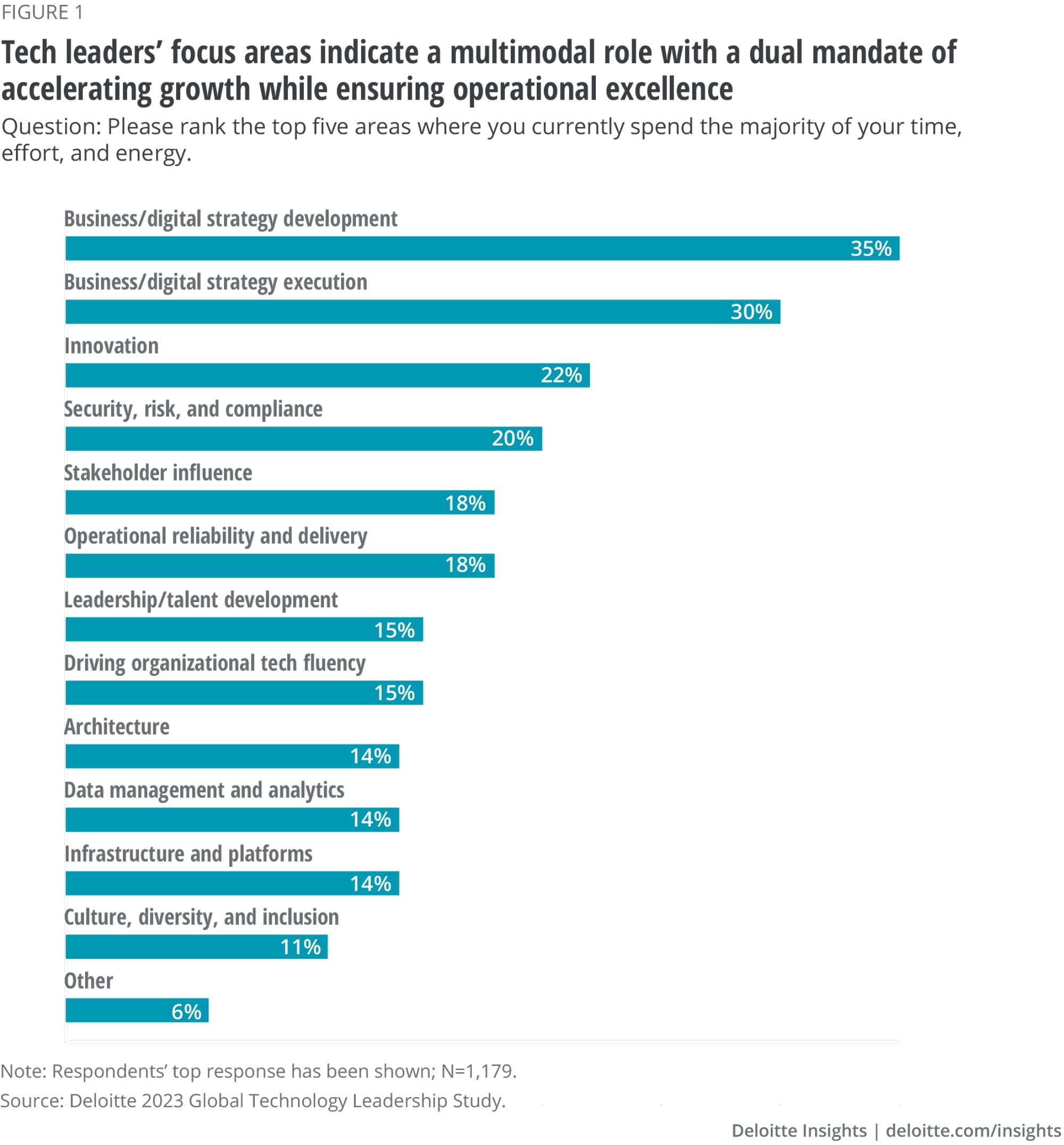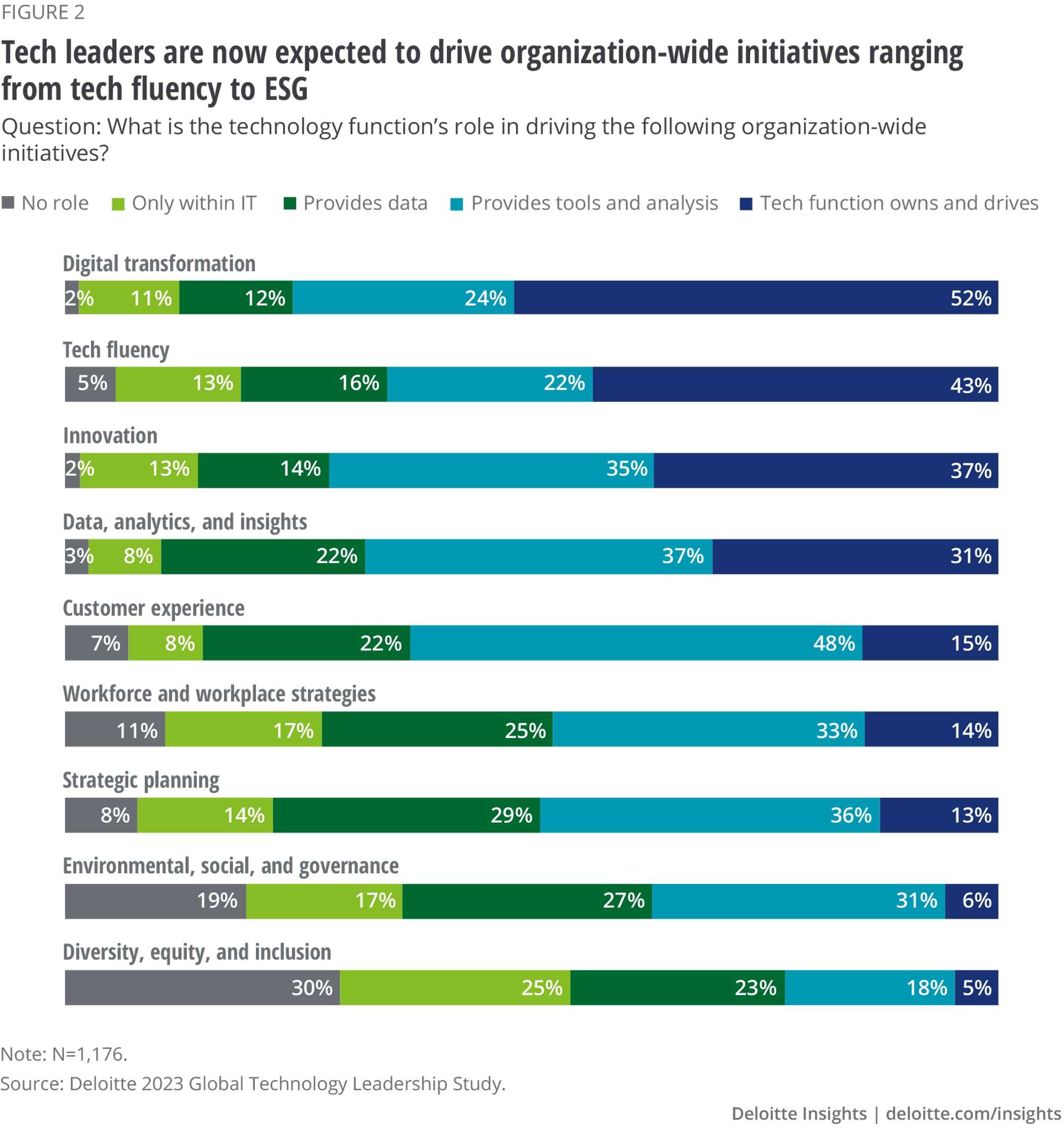In part one of our findings from Deloitte’s 2023 Global Technology Leadership Study, we look at how technology leadership roles have evolved, and the competencies tech executives can build in order to thrive in today’s environment.
Today’s technology leaders understand their role has changed. It’s not enough to be an expert or specialist or independent operator. Instead, technology leadership is now a team sport—and that places an emphasis on the abilities of leaders to collaborate, communicate, coordinate, and co-create.
Tech leaders should lead a synchronized team with multiple talents and competencies, all working toward the transformation of the enterprise. Deloitte’s 2023 Global Technology Leadership Study shows how savvy tech leaders are not only rising to this challenge but also charting new career paths for themselves and the people on their teams.
“The way that technology has been engaged by the business, [and] the way we collaborate, has all changed significantly over the last few years, not just in terms of how we deliver solutions, but how we generate ideas based off business needs and feedback from customers,” says Sathish Muthukrishnan, chief information, data, and digital officer at Ally Financial. “The CIO role and technology is no longer a cost center. I think of the function as a value generator and a revenue generator. Everything we do is critically connected to the business.”
Chris Kozlowski, CTO at TVN, part of Warner Bros Discovery, is also witnessing this evolution first-hand.
“The technology function is changing its role from seamless operations to seamless leadership,” he says. “A few years ago, technology was successful when it was not visible to the business. Now the success is when the technology function ‘invisibly’ coleads the business.”
In this article—the first in a series of four—we explore this shift in more detail and highlight five distinct competencies tech executives can build to become transformational tech leaders.
As part of this year’s study, Deloitte surveyed more than 1,175 global leaders, including chief information officers (CIOs), chief technology officers (CTOs), and other senior technology decision-makers. We also conducted qualitative interviews with more than 100 technology executives spanning a range of sectors. They shared their perspectives on talent shortages, data integrity and security, the rise of automation as well as the reconfiguration of the technology function.
The Evolution of Technology Leadership
Since our 2020 study, technology has continued to reinvent how businesses operate. This, along with the pressures of the COVID-19 pandemic, has contributed to the dispersion and expansion of technology leadership roles. New opportunities for harnessing and monetizing data have emerged, and tech is seen not only as a strategy enabler, but a strategy cocreator.
As a result of these shifts, the responsibilities of tech leaders have become increasingly dispersed. This is evidenced by the rise of the chief data officer, chief digital officer, and other senior technology leadership roles—all disciplines tech leaders should now master, coordinate, and integrate across the enterprise.
About a quarter of the organizations we surveyed report having a chief data officer (27%) or chief digital officer (25%). Seventy-two percent have a chief information officer, 51% have a chief technology officer, and 47% have a chief information security officer. Nine percent of organizations surveyed had all three of these titles—a chief digital officer, a chief data officer, and a chief technology officer.
This dispersion is likely the result of a wide spectrum of expectations. On the one hand, tech leaders may be tasked with being innovative and strategic, and on the other, they may need to ensure operational reliability and cybersecurity. When asked to rank the top five areas where they spend the majority of their time, respondents say they’re expected to prioritize everything from business/digital strategy development (35%) to innovation (22%) to driving organizational tech fluency (15%) (figure 1).

In addition to this dispersion, tech leaders surveyed report an overall expansion in their role—they are expected to drive organization-wide initiatives as varied as tech fluency (43%), innovation (37%), and even strategic planning (13%). Even when they don’t lead a specific initiative, respondents indicated that the expectation is still that the tech function will provide tools and analysis on areas ranging from diversity, equity, and inclusion (DEI) programs to environmental, social, and governance (ESG) efforts (figure 2).

But with so many items on a tech leader’s to-do list, what can actually get done?
Some of the tech leaders surveyed say the key is to be strategic and focused on delivering value. “A lot of people spend time collecting data and never have the time to really do any analysis with it, or at most they just scratch the surface,” says Jennifer Krolikowski, CIO for the US federal government’s Space Systems Command. “It’s not having everybody figure out how to be data scientists. It’s getting to the point that in a matter of minutes, instead of weeks or months, you have power to automate that data, visualize it, and make decisions on it.”
A key, it appears, may be how the tech team divides and conquers—and partners.
When it comes to health care, for example, Brian Lucotch, president of enGen, a subsidiary of Highmark Health, says, “Technology isn’t just the great enabler of business, it’s a key component of the long overdue transformation of the health care industry. We want to bring business and technology closer together so that we not only understand their needs but can also help shape and form their next-generation solutions. Our goal is to bring payers and providers together within our health ecosystem to support patients in their health journeys.”
The Five Competencies of Transformational Technology Leadership
With all of these various roles and responsibilities, how can tech leaders effectively create value?
Our study suggests that those who excel not only have core competencies like tech fluency, data management and monetization, innovation, change management, and business acumen, but they follow a structured, competencies-based approach where they develop and nurture five distinct abilities across their organizations and leadership teams.
- Engineer. These leaders have the ability to build, operate, and optimize business operations and technology capabilities. This competency requires deep operational expertise, technical acumen, and a deep commitment to creating operational value. Their primary responsibility is to build, operate, and maintain technology applications and infrastructure to be efficient, effective, and secure.
- Architect. Architects can envision, design, and oversee technology environments to help ensure resilience and scalability while maintaining agility. These leaders should also stay ahead of new and emerging technologies and continually explore and experiment to keep their organizations competitive.
- Data scientist. These leaders are expected to collect, manage, and analyze data while delivering insights and identifying opportunities to monetize tech assets and drive business growth.
- Change agent. Tech leaders with this competency are experts at instigating, managing, and delivering large complex digital transformations across the enterprise. They deliver value by transforming business processes, employee and customer experiences, and/or business operations.
- Owner. Tech leaders, especially at the business-unit level, should have deep business acumen and stakeholder relationships so they can preemptively identify business challenges and create innovative solutions. This competency allows a tech professional to be viewed as a leader within a business area.
The five competencies detailed above and personified by a diverse team of leaders should be integrated and coordinated. When successful, this approach could create an engine for value—with the possibility of creating multiple career pathways for talented leaders as well as a long-term legacy.
Some of the best tech leaders and organizations could create multidisciplinary teams filled with highly competent leaders at multiple levels of seniority, each with their own portfolio. The technology talent may be dispersed within the organization but could be integrated into a single function. These teams might work across the business and become a source for solutions, as well as early sensors of transformative technologies and potential new value drivers.
Currently, in some organizations, the five competencies are expected to reside within a single role or position—the CIO or highest-ranking tech leader. But it may be time to share and disperse these roles and responsibilities among a team of coordinated leaders. For example, a chief digital officer could focus on organizational transformation, while a chief data officer could focus on data monetization. Ideally, CIOs and tech leaders would help the C-suite make the best use of this matrixed and coordinated team.
When these five competencies reside within the entire technology team—especially at a high level—transformation of the entire enterprise could become more possible. “At Deloitte, since FY20, we’ve worked to grow revenue faster than headcount—liberating 6.7 million hours through standardization, automation and technology across our businesses and enabling areas,” says Doug Beaudoin, Deloitte US Chief Clients and Markets Officer.
At one American manufacturer, leaders have streamlined operations to enhance productivity. “We used to have four or five layers sitting between us and the end customer,” says the company’s former chief digital and information officer. “We’ve taken out layers and did a lot of insourcing because we realized technology is going to be the place to double down in the long term.”
A great tech leader with a strong data competency will bring critical opportunities and issues to the surface. “When I first joined Lilly, we weren’t really using a lot of anomaly detection,” says Diogo Rau, EVP and chief information and digital officer at Eli Lilly and Company. “Now we are doing it in our clinical trials, and we can do it in the manufacturing process to detect defects. Quality of data is incredibly important.”
And a great tech leader, enabled by a competency as a data scientist or a change agent, can also be a powerful voice for the best and highest possible uses of technology investment. “We’re not going to be able to automate ourselves out of this talent shortage,” says the former CIO of a large broadband company. “Human-centered design is probably the single biggest area of impact that we’ve had on the business.”
By using advanced analytics to create and democratize insights throughout the enterprise, a technology team’s data leaders can emerge as an asset to the business. The same can be true for leaders in cybersecurity and data privacy. These are increasingly high-profile and even brand-defining issues for many organizations, and technology leaders could use these portfolios to help build influence in the coming decades. In fact, 70% of respondents said cybersecurity was the digital transformation initiative they’re currently pursuing or planning to pursue in the next two years.
This is perhaps most true in areas of emerging board-level interest. In our study, 49% of tech leaders say the tech function is supporting the measurement of, and compliance to, sustainability goals and regulations, and 47% say the tech function is working on lowering its environmental footprint (through sustainable data centers, energy efficiency, etc.).
Capitalizing on the Moment: What Tech Leaders Should Consider Today
It’s clear that tech leaders have more responsibility than ever before. But with this ever-growing list of mandates and expectations comes opportunity.
The CIO role is no longer necessarily the pinnacle of a tech-based career; the path is open to the COO and/or CEO for the truly skilled professional, and tech leaders who recognize this and rise to the challenges of the moment could see their careers flourish. To deliver value today, consider the following:
- Lead with purpose: Successful tech leaders should build a strong sense of purpose across their organization. One health care CIO said they are able to compete for talent with big tech companies by offering a “compelling mission to serve humanity.” Another CIO in oil and gas said they attract talent with their aggressive stance on developing sustainable energy sources. Almost half (47%) of the technology leaders surveyed reported that having a compelling mission, vision, and purpose allowed them to retain top talent.
- Go slow to go fast: Taking the time to clarify roles, develop guardrails, create efficient decision structures, and develop robust oversight could ultimately allow organizations to move quickly. In organizations that are increasingly matrixed and layered with decision-makers, tech leaders should take the time to establish the governance essential to dynamic but deliberate organizations. Moving from analog to digital governance may require a shift in mindset from control to enablement, from bottlenecks to automated flow, and from friction to cocreation.
- Take on responsibilities beyond the tech domain: Today, technology’s impact spans far beyond IT, so the roles and responsibilities of tech leaders should evolve to the same world-changing level as the technology they’re tasked with managing. To add value, look beyond the IT department. Develop a deep understanding of other disciplines and their needs, or, for instance, consider serving on the board of another company. But remember that delivering value is sometimes only half the battle. Framing, marketing, and communicating this value effectively to various stakeholders is also key and can require special attention, discipline, and skill.
- Embrace multimodal delivery: For decades, monolithic operating models (plan, build, run) worked for technology leaders. Now there are more management and technology options available: Agile vs. waterfall, product vs. project-based, on-premises vs. in the cloud, cocreated or not. Each way of working comes with its own set of considerations.
A strict top-down organization structure can hinder innovation and speed of delivery. At the same time, a purely bottom-up approach can impede learning, re-use, or the ability to scale. Every organization may need to operate across multiple operating modes simultaneously to address their business challenges. Leaders may need to adopt appropriate operating models based on scenarios and requirements. These models should also evolve over time to adapt to new ways of working and business performance results.
- Move from enterprise transformation to transformational leadership: It can be a lot to ask a person to be both an effective tech leader (with all the challenges that entails) as well as an enterprise change leader. Tech leaders may be required to be transformational business leaders, shaping and sparking the ambitions of their entire company while maintaining the integrity of the infrastructure that enables it all.
In our interviews with leading CIOs across the globe we were impressed by the enormity of demands that are placed on these leaders and the scale of impact they have had on their organizations. As tech leaders focus on purpose, governance, agility, and multimodal delivery, they should also build capacity and capability across the enterprise to constantly adapt to change. This could mean taking full advantage of the broader ecosystem or developing in-house alliances to help get the requisite funding and resources to build capacity.
By elevating themselves, tech leaders can help elevate their staff and the next rung of leaders in technology. In a real sense, this could mean tech leaders are not just transforming and reinventing their organizations, but they are also transforming themselves. Many of these actions might not come naturally, but the competencies to perform them can be developed. For tech leaders, this may be a new type of challenge—but it’s the one great leaders rise to meet.
In the end, tech leaders will be prepared for the fresh challenges of their role not by being outstanding at the technical demands of their function. True, these capabilities matter, and are often at the heart of a great technology team, whether they are app development, cloud management, cybersecurity, data monetization, AI, blockchain, or some other critical tech portfolio.
But the great tech leaders of today—and tomorrow—are able to imagine how to assemble these skills within the matrix of the five core competencies that will determine the success of the enterprise. In short, these great tech leaders can prove themselves worthy not only of leading an outstanding team, but an outstanding organization. This is why we believe today’s best tech leaders will become outstanding CEOs and corporate directors. They will have what it takes.
The article was first published here by Deloitte Insights.
Photo by cottonbro studio.

 5.0
5.0 





















